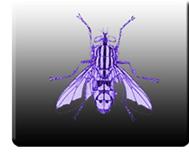Identification of Sphaerocerid Flies
Update£º2016/3/1 16:11:28 View£º

Cheese Skipper Identification
Adult Cheese Skippers are black with bronze tints on the thorax. The eyes of this small fly are reddish-brown and the slightly iridescent wings are held flat over the body when at rest. The entire body is only about half the size of that of the common house fly.
Life Cycle of Cheese Skipper
The adult fly feeds on juices found in areas where they prefer to breed, living just long enough to mate and lay eggs. The female cheese skipper will lay approximately 140 eggs on her food source. The small larvae tend to gather together and feed in one place, burrowing into their food source to avoid light. When mature, larvae leave the food material and seek a dark, dry place to pupate. Under normal to ideal conditions, the cheese skipper larvae complete their development in about five days. It takes as little as 15 days for this fly to develop from egg to mature adult.
Identification of Sphaerocerid Flies
These small flies have dark colored bodies and are about 1/8 inch in length, making proper identification difficult without magnification. The tarsi (last 5 segments of the hind leg) is the key to identifying the Sphaerocerid fly. On this particular fly, the first segment of the tarsi is greatly enlarged.
Sphaerocerid Fly Biology and Life History
The Sphaerocerid fly belongs to a large family of flies known as Sphaeroceridae which contains 241 species in North America. Most flies of this family generally breed in animal manure and can also be known as small dung flies. There are a few species that feed in any decaying organic matter, meaning that they can be found in the same areas as Phorid flies and Fruit flies. The life history is much the same as these other small flies.

